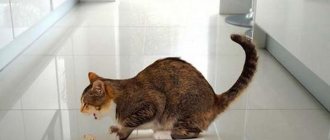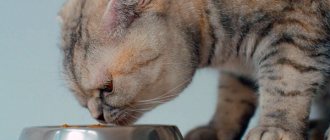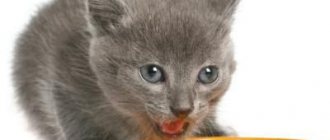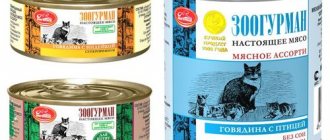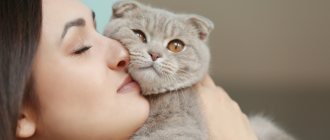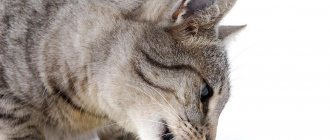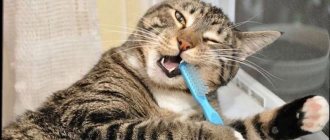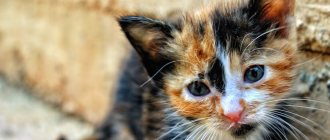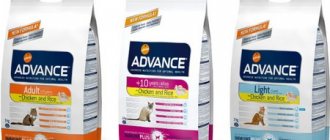How to switch a cat to another food and why might this be necessary? It often happens that the food we buy for our cat is not suitable for her. There can be a lot of reasons: allergies, lack of nutrients and trace elements, or intolerance to any of the ingredients. In the end, it also happens that a loving owner can no longer afford to provide the pet with the usual diet and is forced to look for alternatives, which is especially important during various kinds of crises. But such changes do not always go smoothly.
For what?
There are at least three reasons for switching from one type of diet to another:
- the desire to make the purr’s diet more healthy,
- the desire to save time on cooking (when switching from a natural diet),
- financial issue (when switching from wet food).
Each of them has a completely logical justification:
- Dry food almost always (except for the so-called treats) is complete, that is, it contains all the nutrients your pet needs, and in the quantities required by the animal’s body at a given period of time (hence special foods for kittens, adult cats, etc.). d.).
- It can be stored for a long time without losing its taste and benefits, and does not require time for daily cooking. And, unlike natural ones, you can easily take it on a trip.
- As we have already found out, dry and wet food are equivalent in terms of benefits, however, even within the same price segment, the latter are more expensive. If you want to save on food, but do not want to do it to the detriment of your Murzik’s health, you can switch from canned food to crispy granules.
Transition rules
In order to transfer an animal to a new diet without consequences, it is necessary to adhere to certain rules for the transition. Moreover, in the case of dry food and natural food, there are some nuances.
Something else interesting: Food for castrated and sterilized cats
Dry
When choosing such food, you should give preference to super premium and premium class. The transition is completed within 7–10 days. The animal must be healthy, not pregnant, playful and have regular bowel movements. It is not advisable to switch pets who drink little water to dry food. Otherwise, problems with the bladder and kidneys may occur.
On the first day of changing your diet, you can ignore the dosage. In the first two days, the new food comes as supplements (10–15 “crackers”) to the old diet. It is necessary to soak the dry food a little. Remember that from this time on, your pet should always have enough water. On this diet, the cat will drink 4 times more water!
With each subsequent day, you need to double the dosage of soaked food, while simultaneously reducing the previous diet. By day 10, you should completely change the type of food. A single dosage depending on the age of the pet is indicated on the package.
After switching to dry food, the cat can no longer be fed with natural food or vitamin supplements.
To natural
There are situations when a cat needs to be switched to natural food. Several methods can be used to make this transition.
The forceful method involves stopping the distribution of dry food. In this case, the animal should be offered foods that are easy to digest (offal, boiled chicken meat, cottage cheese), since the previous diet “weaned” the stomach and intestines from proper enzymatic digestion. Food is given in cut pieces, which should be identical in size to dry food. The disadvantage of this method is that the pet may be stubborn and simply go on a hunger strike. In this case, the cat may develop health problems (especially with the liver).
The persuasion method involves gradually reducing the dose of dry food and offering the pet some treats. The choice of treats depends on the individual preferences of the animal. As a result, without unnecessary stress for the cat, it can be gradually switched to natural products.
Something else interesting: Industrial cat food
The mixing method involves adding canned meat to dry food. Gradually the second component should become dominant. You can also gradually introduce vegetables into your diet. The disadvantage of this method is the duration of the transition.
Simultaneously with the transfer, you need to give your pet a complex of lacto- and bifidobacteria or special enzymes. Such supplements will help the intestines restore their function faster.
What not to do
When transferring a pet to a new food format, you should not mix certain types of food (indicated on the product label), or force the animal to eat new food. The cat may independently refuse the new diet, preferring to go on a hunger strike. Without food, a cat can live for three days, after which disturbances in the liver (lipidosis) will begin or gastrointestinal tract disruption will occur, which can lead to death.
It is also prohibited to change the diet at once. The transition had to be smooth, then it would go smoothly and unnoticed by the pet.
The transfer of domestic cats to a new food format should always be carried out according to the rules described above. This is the only way to keep your pet healthy.
How to switch a cat to dry food?
In order to reduce stress, changing your diet should be done gradually. The complete transition will take about 2 weeks:
- From days 1 to 4, dry food should replace 1/4 of the total daily ration. Moreover, it is best not to give out “crunchies” as a separate meal, but to give them along with the cat’s usual food, so that he does not remain hungry if he does not like the granules at first.
- From days 5 to 9, food is given in a 50/50 ratio.
- From 9 a.m. to 1 p.m., 75% of the total daily intake should be dry granules.
- From day 14, the previous diet option can be completely eliminated.
The indicated periods are not the only correct ones and, for example, when transferring an aged cat whose habits and taste preferences have long been formed, they can be increased.
Advice from professionals
Hobbyists often turn to professional breeders for advice on how to best and quickly switch their pets to a more convenient food. Often, in the process of getting used to another product, cats and kittens lose weight. Such a reaction to an unusual type of food is not considered a deviation from the norm. As soon as the animal’s body adapts to the new type of food, the kitten (cat) will begin to gain weight again. In most cases, experts advise dividing the diet into 10 parts when switching an animal to dry food. For ten days, 1/10 of the food is constantly replaced with dry food. This process will lead to the fact that at the end of the tenth day the pet will painlessly switch to a completely different type of feeding without stress to the body.
To stimulate your pet's food intake, you can add catnip to the food. The smell of this plant attracts cats, and the animal will begin to absorb an unfamiliar type of food with a noticeably increased appetite.
Cat mint
When transitioning your pet to kibble, it is recommended to give him probiotics. These medications help normalize intestinal function and make it easier for your mustachioed pet to get used to new types of food. Probiotics can be purchased at any pet store or veterinary pharmacy, but before purchasing, you should consult with your veterinarian, since the use of these drugs is not necessary in all cases.
The final trick
If your pet begins to show character and completely refuses to eat, you can attract his attention simply by soaking the dry food in boiling water. This way its consistency will be much more familiar, and the increased smell will attract attention.
Last but not least, be sure to monitor your purr's health throughout the diet change period, and if you notice any unwanted effects such as vomiting, diarrhea, or coat problems, contact your veterinarian to find the source of the problem. It is quite possible that the animal’s body reacts this way to one of the components in the composition. In this case, the specialist will suggest a brand that is better suited than the one you have chosen.
The animal has grown old
Like all living organisms on this planet, cats age and there is a risk of developing various diseases, including obesity. To avoid this, you need to choose a diet with a lower calorie content. It is better not to use food with a high protein content for an aging animal. But for very old cats, the opposite is true; due to poor absorption of food, the animal may develop vitamin deficiency, so you need to add more vitamins to the diet; protein is also necessary for such a cat.
End of weaning
The pet switches completely to ready-made diets at 6–10 weeks. He absolutely does not have enough mother's milk, but industrial feeds are able to provide the growing body with an increased amount of energy and all the ingredients for full development. However, the owner must take into account the norms shown to the animal and ensure that the kitten, who does not know the saturation limit, does not overeat.
A kitten that is already 1-3 months old should be fed small portions 6 times a day. It’s good if you can do it at the same time to establish a clear routine. During this period, 1 bag of wet food and about 35 grams of dry food are consumed per day.
As the kitten gets older, its feeding schedule also changes: at 4–5 months of age, the pet should eat 3–4 times a day, eating a bag of wet food in the morning and evening and 35 grams of dry food during the day. A 6-9 month old kitten should be given food with the same frequency, but in larger portions: every day the kitten will eat 2 bags of wet food and about 70 grams of dry food per day.
Subscribe to our newsletter and get a free veterinary consultation
Thanks for subscribing!
Preparing for your trip
Whatever type of transport you plan to travel with, you will need a special container bag for transporting your cat. Nowadays there is a huge selection of carriers in stores: plastic, metal and fabric. Remember that a cat is a freedom-loving animal, and under stress its strength increases many times over.
Tip 1 : Buy a good, strong carrier, preferably a plastic one with a metal door. Rigid carrying makes it more convenient for transport; you can safely put it on the seat of a car or bus, on a shelf on a train, or on the floor of an airplane. Even in crowded conditions, nothing will happen to the animal. And the cat herself will be more comfortable in it. In addition, you can insert a small toilet tray into a hard container, which is important.
If you have to travel by plane (especially abroad), then the choice is clear: an animal transported only in a rigid carrier is allowed for the flight. Sometimes and only certain companies - or “tortuga” (“MARCHIORO”, Italy). Some airlines allow the Atlas to be carried. (read more about choosing a carrier here)
Tip 2 : if you spend less than a day on the road, it is better for your cat to fast. If the trip is long, stock up on food (in this case, dry food is irreplaceable), boiled water, and small, stable bowls for food and water.
Tip 3 : You should also take a tray and wet wipes on the road (there are sanitary napkins for animals). You can place an absorbent pet mat or absorbent diapers on the bottom of the carrier. Experienced travelers advise sewing a carrying case made of dark fabric so that the cat feels calmer in a darkened space and is not frightened by flashes from the sides of the container.
Tip 4 : Do not let your cat out on a train, bus or car unless absolutely necessary. Her behavior in a stressful situation is uncontrollable, and escape is also possible (of course, there are cats that calmly endure the journey, but this is rather the exception). If the path is not close, it is best to put a harness and leash on the cat in advance for the walk.
Tip 5 : it is advisable to accustom your cat to both the carrier and the harness in advance in a calm home environment.
Tip 6 : Travel can be very stressful for your indoor cat, so you should reduce her anxiety. They begin to give sedatives in advance, 3 to 5 days before departure. You should not give your cat valerian (on the contrary, it can have an stimulating effect), as well as tranquilizers that lower blood pressure (especially dangerous during changes in atmospheric pressure during flight). The best are natural herbal-based sedatives: “Cat Bayun”, “Fitex”, “Stop-stress” (this drug has a moderate sedative effect without a hypnotic effect).
Tip 7 : A fellow passenger may be allergic to animals. Therefore, just in case, take some antihistamine with you.
And now the second question:
